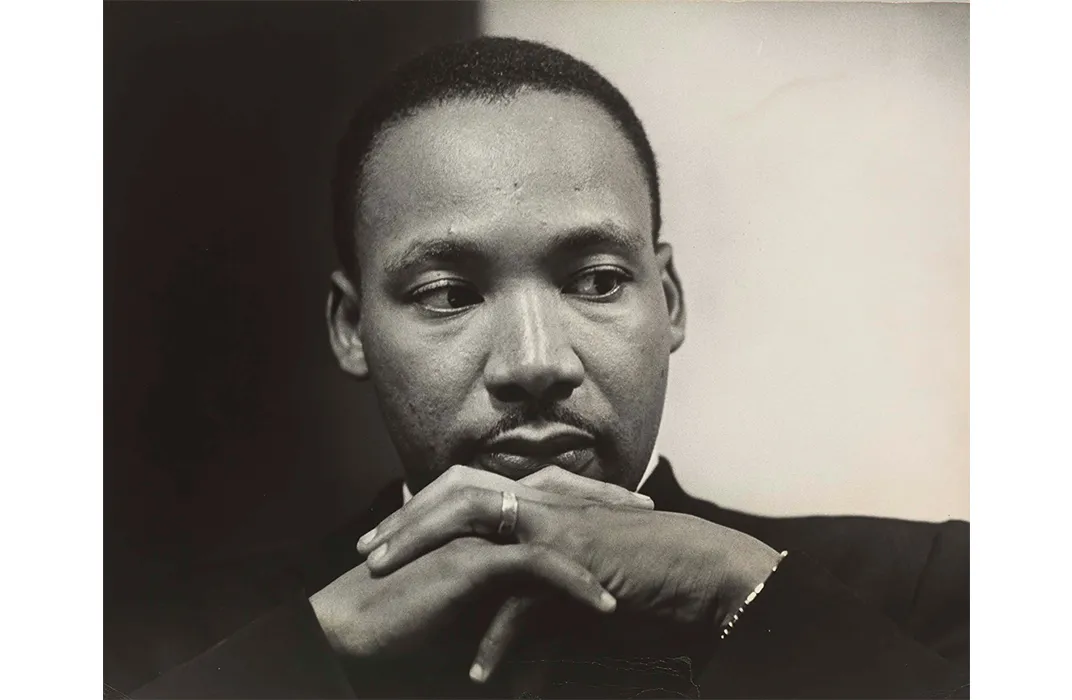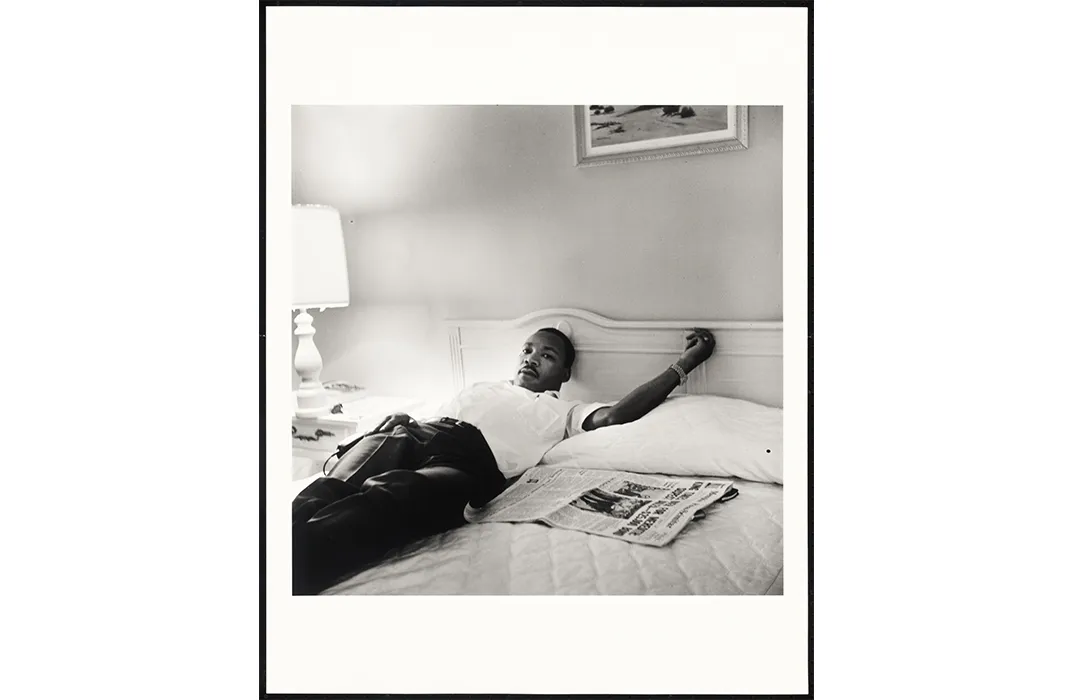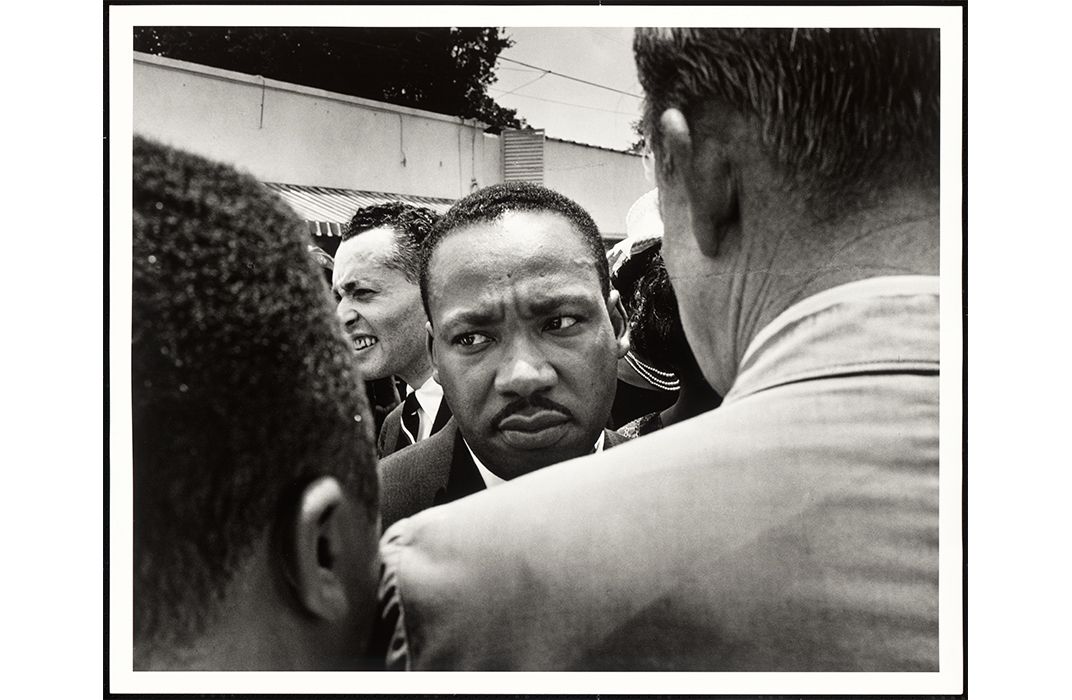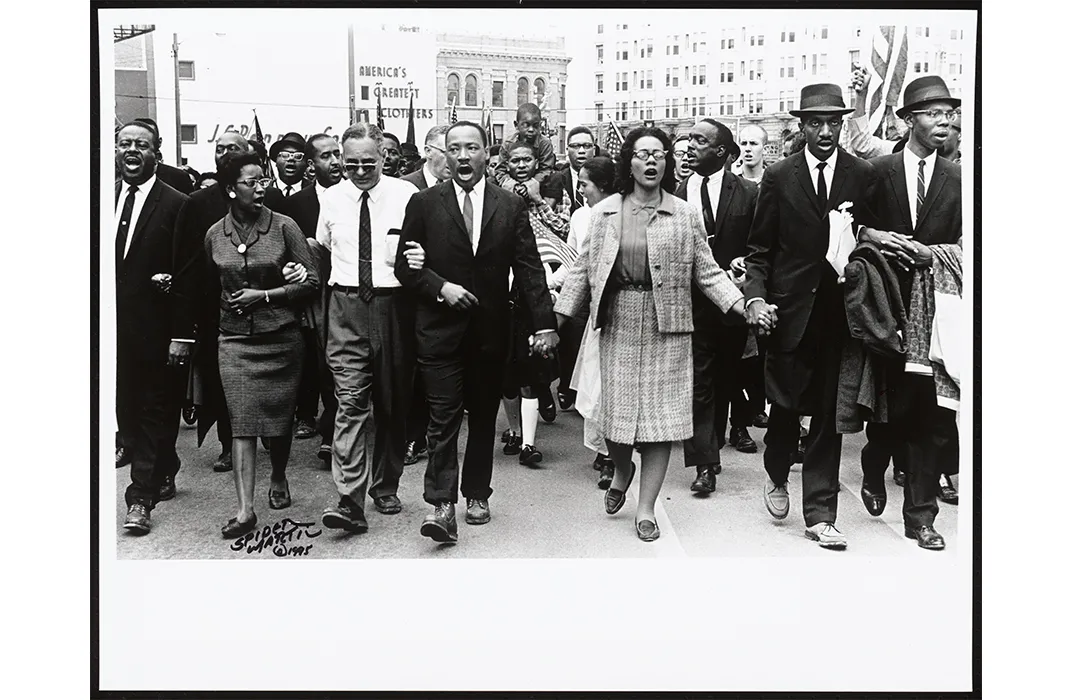Dr. Martin Luther King, Jr. shortly after his release from Reidsville Penitentiary, Georgia, 1960. Dr. King was arrested during a student-led protest at an Atlanta department store. He and the arrested students refused to leave until all charges against them were dropped. King had violated probation for an earlier traffic citation and was sentenced to four months of hard labor and taken to Reidsville Penitentiary. Then presidential candidate John F. Kennedy called King's wife Coretta to console her, but his brother Robert Kennedy placed the call that led to King's release.
National Portrait Gallery, Smithsonian Institution, gift of Jack Lewis Hiller, ©1960 Jack L. Hiller
Dr. Martin Luther King, Jr. marches from Central Park to the United Nations Plaza in a demonstration against the Vietnam War with thousands of protesters, including Dr. Benjamin Spock (left) and Monsignor Charles Owen Rice (right), New York City, April 15, 1967. Dr. King strongly believed that U.S. involvement in Vietnam was taking valuable resources away from poverty and civil rights in America. A winner of the Nobel Peace Prize, King spoke to Riverside Church in New York City over a week before the march saying, "If America's soul becomes totally poisoned, part of the autopsy must read Vietnam."
National Portrait Gallery, Smithsonian Institution, © Benedict J. Fernandez
Dr. Martin Luther King, Jr. at the March on Washington for Jobs and Freedom on August 28, 1963. After one of King's closest friends, Mahalia Jackson, called out "Tell them about the dream, Martin. Tell them about the dream," King decided to stop what he had prepared and gave his famous "I Have a Dream" speech to a crowd of more than 250,000.
National Portrait Gallery, Smithsonian Institution, © Bob Adelman
Dr. Martin Luther King, Jr. speaking during a rally in Birmingham’s Sixteenth Street Baptist Church, 1963.
National Portrait Gallery, Smithsonian Institution, © Bruce Davidson / Howard Greenberg Gallery
Reverend Theodore M. Hesburgh and Dr. Martin Luther King, Jr. at the Illinois Rally for Civil Rights, June 21, 1964. The U.S. Senate had passed the Civil Rights Bill two days earlier, and at the end of the rally, King and Hesburgh joined hands during the song "We Shall Overcome."
National Portrait Gallery, Smithsonian Institution, gift of the University of Notre Dame in honor of the Rev. Theodore M. Hesburgh, C.S.C.
Dr. Martin Luther King, Jr. at Dexter Avenue Baptist Church, Montgomery, Alabama, 1955. During King's third year living in Boston, he began looking for work and was asked to preach trial sermons at Dexter Avenue Baptist Church, among others. In January 1954, King preached at the church for the first time, and in April he accepted the church's pastorship. On September 5, 1954 he gave his first sermon as their resident pastor.
Collection of the Smithsonian National Museum of African American History & Culture, © Charles Moore
Dr. Martin Luther King, Jr. with Coretta Scott King and their daughter, Yolanda, on the steps of the Dexter Avenue Baptist Church, 1956. The couple met while Dr. King was studying at Boston University, and she was at the New England Conservatory of Music. They married in June 1953, and Yolanda was born in November 1955.
National Portrait Gallery, Smithsonian Institution © Sandra Weiner
Dr. Martin Luther King, Jr. and Coretta Scott King laugh during entertainment at the St. Jude Hospital in Montgomery the night before the march to the Capitol, 1965.
Collection of the Smithsonian National Museum of African American History & Culture, © 1965 Spider Martin
Dr. Martin Luther King, Jr. rests in Lorraine Motel following the March Against Fear, Memphis, Tennessee, 1966.
Collection of the Smithsonian National Museum of African American History & Culture, © Ernest C. Withers Trust
Dr. Martin Luther King, Jr. is arrested for loitering outside of a courtroom where his friend Ralph Abernathy appeared for a trial, Montgomery, Alabama, 1958. King was arrested 30 times throughout his life while participating in civil rights activities.
Collection of the Smithsonian National Museum of African American History & Culture, © Charles Moore
Dr. Martin Luther King, Jr. is arrested in Montgomery, Alabama, 1958.
Collection of the Smithsonian National Museum of African American History & Culture, © Charles Moore
Dr. Martin Luther King, Jr. is stopped by police at Medgar Evers' funeral in Jackson, Mississippi, June 1963. Evers, a leader of the civil rights movement, was shot to death in the driveway of his home. As a soldier in the Normandy invasion during World War II, Evers was put to rest at Arlington National Cemetery with full honors.
Collection of the Smithsonian National Museum of African American History & Culture, © Ernest C. Withers Trust
Dr. King and others marching for voting rights come into Montgomery, 1965. The march from Selma to Montgomery, Alabama began with the infamous "Bloody Sunday." While leaving Selma, marchers were ordered to stop by about 150 officials who gave the activists a two-minute warning to stop. One minute and five seconds after the announcement the officials moved toward the marchers with clubs, bullwhips and tear gas. 58 people had injuries treated at the hospital.
Collection of the Smithsonian National Museum of African American History & Culture, © 1965 Spider Martin
To find out more about the life of Dr. Martin Luther King, Jr. and the civil rights movement take time this weekend to visit some of the Smithsonian's exhibits, events and online resources. See some of the images in this gallery and more at the National Portrait Gallery's One Life: Martin Luther King, Jr. exhibition. The exhibit has Portrait Story Day events scheduled throughout the long weekend. Participants can create a work of art while listening to stories about Dr. King and the civil rights movement.
Changing America: The Emancipation Proclamation, 1863 and the March on Washington, 1963 at the National Museum of American History features exhibition tours Saturday and Sunday at 10:30 am, 12:00 pm and 1 pm. Visitors to the museum can also talk with a reenactor playing a civil rights activist from 1960 during several 20-minute performances Saturday through Monday at the Greensboro Lunch Counter . The performances include a training session, based on a 1960s manual, to prepare visitors for their first sit-in.
Get the latest stories in your inbox every weekday.

/https://tf-cmsv2-smithsonianmag-media.s3.amazonaws.com/filer/4b/a1/4ba1fb84-765d-403e-81f5-5d9868d5e296/02-king-duke.jpg)
/https://tf-cmsv2-smithsonianmag-media.s3.amazonaws.com/filer/ab/fe/abfea220-2e84-4378-ba0e-302a1d9dbcbd/12-mlk_adelman_npg_2006_16.jpg)
/https://tf-cmsv2-smithsonianmag-media.s3.amazonaws.com/filer/e1/3b/e13b3557-6167-4a13-a8d8-47ca52ff855b/14-mlk_davidson_npg_96_167.jpg)
/https://tf-cmsv2-smithsonianmag-media.s3.amazonaws.com/filer/d3/06/d306ee4f-d522-44e0-8426-311ccea8d447/17-mlk-and-hesburgh_unid_npg_2007_205_d1.jpg)
/https://tf-cmsv2-smithsonianmag-media.s3.amazonaws.com/filer/b0/9b/b09b83fc-1a35-46bc-970c-bbe20539ab1b/19-19-mlk-preaching.jpg)
/https://tf-cmsv2-smithsonianmag-media.s3.amazonaws.com/filer/cd/c5/cdc59c15-77ef-4125-bdb3-7d9d77ff5a63/20-16-mlk_weiner_npg_94_253-r.jpg)
/https://tf-cmsv2-smithsonianmag-media.s3.amazonaws.com/filer/cc/cc/cccc7271-1166-4e44-bc5b-a2ca246fc4f5/21-20-mlk-and-coretta.jpg)

/https://tf-cmsv2-smithsonianmag-media.s3.amazonaws.com/filer/25/19/25196994-d4d5-488a-9051-c5d2756517c2/23-22-mlk-arrest-counter.jpg)
/https://tf-cmsv2-smithsonianmag-media.s3.amazonaws.com/filer/9a/81/9a81eebf-c476-4e14-b257-8156e9dcf357/24-24-king-arrested.jpg)

